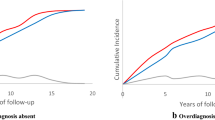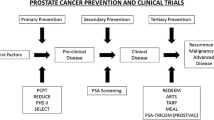Abstract
The Prostate Cancer Prevention Trial is the first phase III (randomized, placebo-controlled, prospective) population-based study to determine whether the risk of prostate cancer can be reduced. Between 1994 and 1997, 18,882 men were randomized to either finasteride or placebo at 219 sites in the United States. The study design included annual digital rectal examination and PSA determinations with PSA performed centrally with reports provided to sites corrected for treatment arm (as finasteride lowers PSA level). Because of a number of potential biases that could confound disease ascertainment all patients were scheduled for an end-of-study prostate biopsy. End-of-study prostate biopsies began in 2000, and the final biopsy is expected in 2004, with results of the study anticipated shortly thereafter. The high participant interest and extensive data collected for this study demonstrate the extraordinary opportunity for chemoprevention trials of prostate cancer in the United States
Similar content being viewed by others
References
Gormley GJ, Stoner E, Bruskewitz RC, Imperato-McGinley J, Walsh PC, McConnell JD, Andriole GL, Geller J, Bracken BR, Tenover JS, et al (1992) The effect of finasteride in men with benign prostatic hyperplasia. The Finasteride Study Group. N Engl J Med 327:1185–1191
Imperato-McGinley J, Gautier T, Zirinsky K, et al (1992) Prostate visualization studies in males homozygous and heterozygous for 5-alpha reductase deficiency. J Clin Endocrinol Metab 75:1022–1026
Kyprianou N, Isaacs J (1989) Expression of transforming growth factor-beta in the rat ventral prostate during castration-induced programmed cell death. Mol Endocrinol 3:1515–1522
Pour PM, Groot K, Kazakoff K, et al (1991) Effects of high-fat diet on teh patterns of prostatic cancer induced in rats by N-nitrosobis (2-oxopropyl-amine and testosterone). Cancer Res 51:4757–4761
Ross RK, Bernstein L, Lobo RA, Shimuzu H, Stanczyk FZ, Pike MC, Henderson BE (1992) 5-Alpha reductase activity and risk of prostate cancer among Japanese and US white and black males. Lancet 339:887–889
Sartor O (2000) Molecular factors in the assessment of prostate cancer risk. In: Resnick MI, Thompson IM (eds) Advanced therapy of prostate disease. Decker, Hamilton, pp 44–49
Stoner E (1990) The clinical development of a 5 alpha-reductase inhibitor, finasteride. J Steroid Biochem Mol Biol 37:375–378
Author information
Authors and Affiliations
Corresponding author
Rights and permissions
About this article
Cite this article
Thompson, I.M., Tangen, C. & Goodman, P. The Prostate Cancer Prevention Trial: design, status, and promise. World J Urol 21, 28–30 (2003). https://doi.org/10.1007/s00345-002-0315-y
Received:
Accepted:
Published:
Issue Date:
DOI: https://doi.org/10.1007/s00345-002-0315-y




